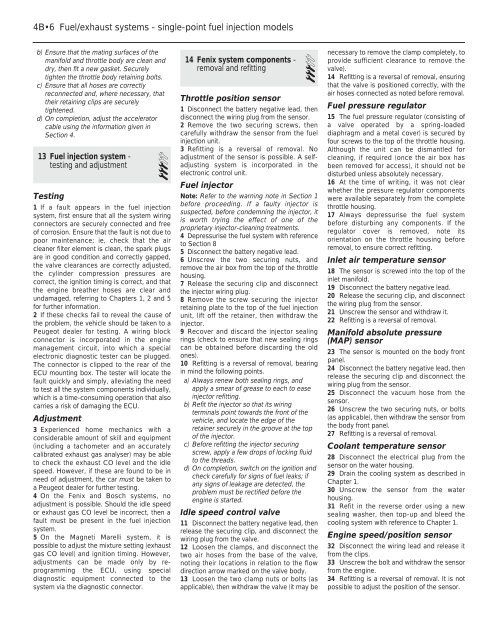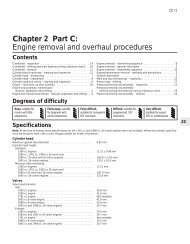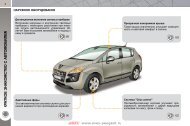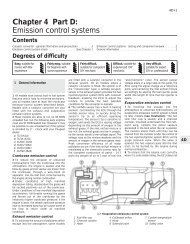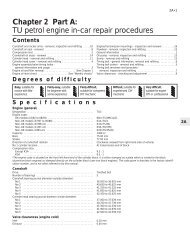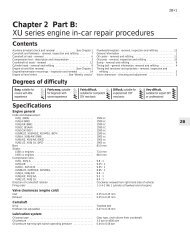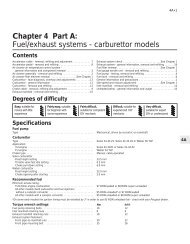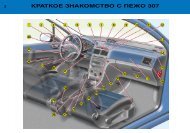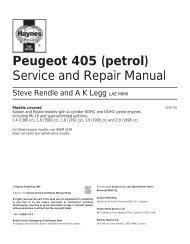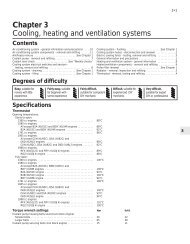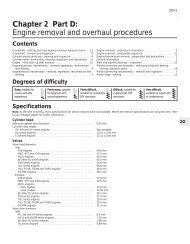Chapter 4 Part B: Fuel/exhaust systems - single-point fuel injection ...
Chapter 4 Part B: Fuel/exhaust systems - single-point fuel injection ...
Chapter 4 Part B: Fuel/exhaust systems - single-point fuel injection ...
- No tags were found...
You also want an ePaper? Increase the reach of your titles
YUMPU automatically turns print PDFs into web optimized ePapers that Google loves.
4B•6 <strong>Fuel</strong>/<strong>exhaust</strong> <strong>systems</strong> - <strong>single</strong>-<strong>point</strong> <strong>fuel</strong> <strong>injection</strong> modelsb) Ensure that the mating surfaces of themanifold and throttle body are clean anddry, then fit a new gasket. Securelytighten the throttle body retaining bolts.c) Ensure that all hoses are correctlyreconnected and, where necessary, thattheir retaining clips are securelytightened.d) On completion, adjust the acceleratorcable using the information given inSection 4.13 <strong>Fuel</strong> <strong>injection</strong> system -testing and adjustment3Testing1 If a fault appears in the <strong>fuel</strong> <strong>injection</strong>system, first ensure that all the system wiringconnectors are securely connected and freeof corrosion. Ensure that the fault is not due topoor maintenance; ie, check that the aircleaner filter element is clean, the spark plugsare in good condition and correctly gapped,the valve clearances are correctly adjusted,the cylinder compression pressures arecorrect, the ignition timing is correct, and thatthe engine breather hoses are clear andundamaged, referring to <strong>Chapter</strong>s 1, 2 and 5for further information.2 If these checks fail to reveal the cause ofthe problem, the vehicle should be taken to aPeugeot dealer for testing. A wiring blockconnector is incorporated in the enginemanagement circuit, into which a specialelectronic diagnostic tester can be plugged.The connector is clipped to the rear of theECU mounting box. The tester will locate thefault quickly and simply, alleviating the needto test all the system components individually,which is a time-consuming operation that alsocarries a risk of damaging the ECU.Adjustment3 Experienced home mechanics with aconsiderable amount of skill and equipment(including a tachometer and an accuratelycalibrated <strong>exhaust</strong> gas analyser) may be ableto check the <strong>exhaust</strong> CO level and the idlespeed. However, if these are found to be inneed of adjustment, the car must be taken toa Peugeot dealer for further testing.4 On the Fenix and Bosch <strong>systems</strong>, noadjustment is possible. Should the idle speedor <strong>exhaust</strong> gas CO level be incorrect, then afault must be present in the <strong>fuel</strong> <strong>injection</strong>system.5 On the Magneti Marelli system, it ispossible to adjust the mixture setting (<strong>exhaust</strong>gas CO level) and ignition timing. However,adjustments can be made only by reprogrammingthe ECU, using specialdiagnostic equipment connected to thesystem via the diagnostic connector.14 Fenix system components -removal and refitting3Throttle position sensor1 Disconnect the battery negative lead, thendisconnect the wiring plug from the sensor.2 Remove the two securing screws, thencarefully withdraw the sensor from the <strong>fuel</strong><strong>injection</strong> unit.3 Refitting is a reversal of removal. Noadjustment of the sensor is possible. A selfadjustingsystem is incorporated in theelectronic control unit.<strong>Fuel</strong> injectorNote: Refer to the warning note in Section 1before proceeding. If a faulty injector issuspected, before condemning the injector, itis worth trying the effect of one of theproprietary injector-cleaning treatments.4 Depressurise the <strong>fuel</strong> system with referenceto Section 85 Disconnect the battery negative lead.6 Unscrew the two securing nuts, andremove the air box from the top of the throttlehousing.7 Release the securing clip and disconnectthe injector wiring plug.8 Remove the screw securing the injectorretaining plate to the top of the <strong>fuel</strong> <strong>injection</strong>unit, lift off the retainer, then withdraw theinjector.9 Recover and discard the injector sealingrings (check to ensure that new sealing ringscan be obtained before discarding the oldones).10 Refitting is a reversal of removal, bearingin mind the following <strong>point</strong>s.a) Always renew both sealing rings, andapply a smear of grease to each to easeinjector refitting.b) Refit the injector so that its wiringterminals <strong>point</strong> towards the front of thevehicle, and locate the edge of theretainer securely in the groove at the topof the injector.c) Before refitting the injector securingscrew, apply a few drops of locking fluidto the threads.d) On completion, switch on the ignition andcheck carefully for signs of <strong>fuel</strong> leaks; ifany signs of leakage are detected, theproblem must be rectified before theengine is started.Idle speed control valve11 Disconnect the battery negative lead, thenrelease the securing clip, and disconnect thewiring plug from the valve.12 Loosen the clamps, and disconnect thetwo air hoses from the base of the valve,noting their locations in relation to the flowdirection arrow marked on the valve body.13 Loosen the two clamp nuts or bolts (asapplicable), then withdraw the valve (it may benecessary to remove the clamp completely, toprovide sufficient clearance to remove thevalve).14 Refitting is a reversal of removal, ensuringthat the valve is positioned correctly, with theair hoses connected as noted before removal.<strong>Fuel</strong> pressure regulator15 The <strong>fuel</strong> pressure regulator (consisting ofa valve operated by a spring-loadeddiaphragm and a metal cover) is secured byfour screws to the top of the throttle housing.Although the unit can be dismantled forcleaning, if required (once the air box hasbeen removed for access), it should not bedisturbed unless absolutely necessary.16 At the time of writing, it was not clearwhether the pressure regulator componentswere available separately from the completethrottle housing.17 Always depressurise the <strong>fuel</strong> systembefore disturbing any components. If theregulator cover is removed, note itsorientation on the throttle housing beforeremoval, to ensure correct refitting.Inlet air temperature sensor18 The sensor is screwed into the top of theinlet manifold.19 Disconnect the battery negative lead.20 Release the securing clip, and disconnectthe wiring plug from the sensor.21 Unscrew the sensor and withdraw it.22 Refitting is a reversal of removal.Manifold absolute pressure(MAP) sensor23 The sensor is mounted on the body frontpanel.24 Disconnect the battery negative lead, thenrelease the securing clip and disconnect thewiring plug from the sensor.25 Disconnect the vacuum hose from thesensor.26 Unscrew the two securing nuts, or bolts(as applicable), then withdraw the sensor fromthe body front panel.27 Refitting is a reversal of removal.Coolant temperature sensor28 Disconnect the electrical plug from thesensor on the water housing.29 Drain the cooling system as described in<strong>Chapter</strong> 1.30 Unscrew the sensor from the waterhousing.31 Refit in the reverse order using a newsealing washer, then top-up and bleed thecooling system with reference to <strong>Chapter</strong> 1.Engine speed/position sensor32 Disconnect the wiring lead and release itfrom the clips.33 Unscrew the bolt and withdraw the sensorfrom the engine.34 Refitting is a reversal of removal. It is notpossible to adjust the position of the sensor.


